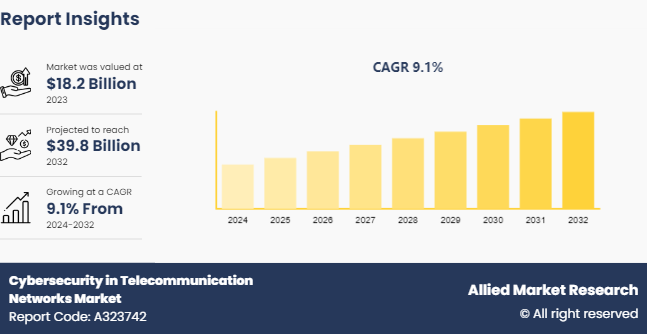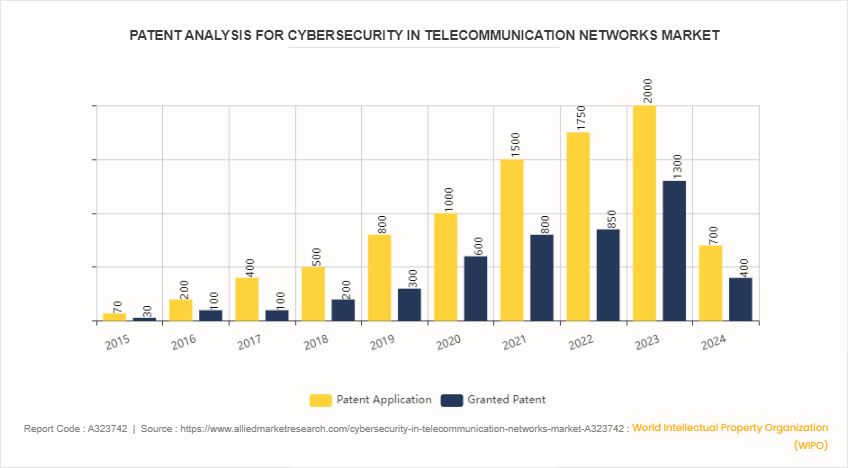Cybersecurity In Telecommunication Networks Market Research, 2032
The global cybersecurity in telecommunication networks market size was valued at $18.2 billion in 2023, and is projected to reach $39.8 billion by 2032, growing at a CAGR of 9.1% from 2024 to 2032. Cybersecurity in telecommunication networks refers to the practices and technologies used to protect communication infrastructures from unauthorized access, data breaches, and cyberattacks. It ensures the confidentiality, integrity, and availability of data transmitted across these networks.

Market Introduction and Definition
Cybersecurity in telecommunication networks refers to the measures and practices implemented to protect these networks from cyber threats and attacks. Telecommunication networks play a crucial role in transmitting data and voice communications over various platforms, making them prime targets for malicious actors seeking to gain unauthorized access, disrupt services, or steal sensitive information.
Cybersecurity in telecommunication networks involves strategies such as implementing firewalls to protect against unauthorized access, encryption to secure data in transit and at rest, and authentication protocols to verify the identity of users and devices accessing the network. These security measures are essential for safeguarding telecommunication networks from a range of cyber threats, including denial-of-service attacks, data breaches, and other malicious activities that are anticipated to compromise the integrity and confidentiality of network communications and data.
Key Takeaways
The cybersecurity in telecommunication networks market share study covers 20 countries. The research includes a segment analysis of each country in terms of value ($million) for the projected period.
More than 1, 500 product literatures, industry releases, annual reports, and other such documents of major cybersecurity in telecommunication networks industry participants along with authentic industry journals, trade associations' releases, and government websites have been reviewed for generating high-value industry insights.
The study integrated high-quality data, professional opinions and analysis, and critical independent perspectives. The research approach is intended to provide a balanced view of global markets and to assist stakeholders in making educated decisions to achieve their most ambitious growth objectives.
Key Market Dynamics
The cybersecurity in telecommunication networks market growth is driven by the rapid growth of 5G technology and the Internet of Things (IoT) , leading to an increased attack surface for cyber threats, making cybersecurity a critical concern for telecommunication providers. The escalating complexity of telecommunication infrastructures provides cybercriminals with numerous opportunities to exploit vulnerabilities, resulting in a surge of cyberattacks such as DDoS attacks, data breaches, and ransomware, therby drives the cybersecurity in telecommunication networks market forecast period. Furthermore, telecom companies are countering these threats by implementing robust security strategies, including multi-factor authentication, encryption, firewalls, and user education.
However, budgetary constraints hinder organizations from allocating sufficient resources to fortify their defenses. On the contrary, the government and business investments to enhance cybersecurity infrastructure, which is furture driving cybersecurity in telecommunication networks market forecast period and its economic growth in the cybersecurity landscape.
Patent Analysis Overview of the Global Cybersecurity in Telecommunication Networks Market
A surge in patent filings related to cybersecurity technologies reflects the industry's rapid growth and innovation. Companies such as IBM, Microsoft, and Huawei have emerged as key players with substantial patent portfolios in this space, indicating a strong focus on protecting their intellectual property internationally. The analysis highlights the increase in importance of cybersecurity in telecommunication networks, driven by the evolution of technologies such as 5G and IoT, which have expanded the attack surface for cyber threats. In addition, the analysis underscores the significance of robust security strategies, such as multi-factor authentication, encryption, and firewalls, in safeguarding telecommunication networks against cyberattacks such as DDoS attacks, data breaches, and ransomware.

Market Segmentation
The cybersecurity in telecommunication networks market is segmented into component, deployment mode, enterprise size, and region. On the basis of component, the market is divided into software and service. On the basis of deployment mode, the market is bifurcated into on-premise and cloud. On the basis of enterprise size, the market is categorized into small and medium-sized enterprises and large enterprises. Region-wise, the market is analyzed across North America, Europe, Asia-Pacific, LAMEA.
Regional/Country Market Outlook
In the UK, the UK Government instigated new telecom security regulations and an accompanying draft code of practice in Parliament, reflecting that the threat of cybercrime is very strong. Under the new UK telecoms security regulations, announced on August 31, 2022, UK telecom companies face fines of up to 10% of their turnover if they don’t follow industry best practices when it comes to protecting networks from cyberattacks. Ofcom will be responsible for overseeing and enforcing the new code of conduct with the introduction of the new rules.
In Brazil, the National Telecommunications Agency (“ANATEL”) , the body that regulates telecommunications in Brazil, employing Resolution No. 740, dated December 21, 2020, approved the Cybersecurity Regulation Applied to the Telecommunications Sector (“Regulation”) , which entered into force on January 4, 2021. The purpose of the Regulation is to establish conducts and procedures to promote security in telecommunications networks and services, including cybersecurity and the protection of critical telecommunications infrastructures.
Industry Trends
The emergence of the Internet of Things (IoT) and the 5G network has presented the telecommunications industry with a new set of challenges. Cybersecurity threats have been escalating and have become a significant concern for telecommunication providers. With the proliferation of connected devices, telecommunication networks are becoming increasingly susceptible to cyberattacks, such as distributed denial-of-service (DDoS) attacks, data breaches, and ransomware. Telecom companies are implementing various security strategies, including multi-factor authentication, encryption, firewalls, and user education to safeguard against these threats. For instance, in February 2024, Cisco collaborated with du, from Emirates Integrated Telecommunications Company (EITC) , signaling the beginning of a major cybersecurity transformation initiative. The initiative focuses on revolutionizing du’s Security Operations Center (SOC) into an advanced Cyber Defense and Intelligence Center, leveraging artificial intelligence and automation to enhance security and operational efficiency.
According to Access Partnership Ltd., with a rapidly growing population of 500 million internet users, Africa has one of the world's fastest-expanding telephone and internet networks, which has led to a parallel surge in cybercrime, necessitating the integration of cybersecurity into business strategies and policy considerations across the continent. This developing digital landscape also makes Africa an attractive target for foreign platforms seeking to expand their user bases, particularly in light of the recently established African Continental Free Trade Agreement, which aims to create the world's largest free trade area in terms of participating nations (54) , connecting over 1.3 billion individuals with a combined GDP of USD 3.4 trillion and projected personal and commercial expenditure of USD 6.7 trillion. Consequently, Africa's accelerating internet penetration coupled with the increase in free trade movement positions the continent for substantial growth in the coming years, underscoring the critical importance of effective cyberspace governance as a core issue in international foreign policy and law.
Competitive Landscape
The major players operating in the cybersecurity in telecommunication networks market include Cisco Systems, Inc.; Palo Alto Networks; Verizon; AT&T Intellectual Property; Zscaler, Inc.; Trend Micro Incorporated; Broadcom; McAfee, LLC; Juniper Networks, Inc.; and Fortinet, Inc. Other players in the cybersecurity in telecommunication networks market include Check Point Software Technologies Ltd.; Ericsson, and others.
Recent Key Strategies and Developments in Cybersecurity in Telecommunication Networks Industry
In March 2024, Zscaler, Inc. formed an expanded partnership with UK-based fixed and mobile telecommunications provider BT Group Plc to provide its Zscaler AI-driven Zero Trust Exchange cloud security platform. As part of this partnership, Zscaler also supplies BT Group with security solutions to protect its operations.
In November 2023, AT&T announced an agreement to create a standalone managed cybersecurity services business, and a capital investment in that business from WillJam Ventures, a Chicago-based investor with deep cybersecurity industry and leadership experience.
In July 2022, Juniper Networks, a leader in secure, AI-driven networks, and Dragos, a global leader in cybersecurity for Industrial Control Systems (ICS) and Operational Technology (OT) environments, announced their commitment to securing critical infrastructure through an official joint partnership that provides an automation framework for active attack response for OT-ICS networks and systematizes the research and development work done by both companies.
Key Sources Referred
National Institute of Standards and Technology
Cybersecurity and Infrastructure Security Agency
Federal Communications Commission
Communications Security Establishment
Telecommunications Regulatory Authority
Key Benefits For Stakeholders
- This report provides a quantitative analysis of the market segments, current trends, estimations, and dynamics of the cybersecurity in telecommunication networks market analysis from 2024 to 2032 to identify the prevailing cybersecurity in telecommunication networks market opportunities.
- The market research is offered along with information related to key drivers, restraints, and opportunities.
- Porter's five forces analysis highlights the potency of buyers and suppliers to enable stakeholders make profit-oriented business decisions and strengthen their supplier-buyer network.
- In-depth analysis of the cybersecurity in telecommunication networks market segmentation assists to determine the prevailing market opportunities.
- Major countries in each region are mapped according to their revenue contribution to the global market.
- Market player positioning facilitates benchmarking and provides a clear understanding of the present position of the market players.
- The report includes the analysis of the regional as well as global cybersecurity in telecommunication networks market trends, key players, market segments, application areas, and market growth strategies.
Cybersecurity in Telecommunication Networks Market Report Highlights
| Aspects | Details |
| Market Size By 2032 | USD 39.8 Billion |
| Growth Rate | CAGR of 9.1% |
| Forecast period | 2024 - 2032 |
| Report Pages | 356 |
| By Component |
|
| By Deployment Mode |
|
| By Enterprise Size |
|
| By Region |
|
| Key Market Players | Zscaler, Inc., Trend Micro Incorporated, Check Point Software Technologies Ltd., Juniper Networks, Inc., AT&T Intellectual Property, Broadcom, McAfee, LLC, Verizon, Cisco Systems, Inc., Ericsson, Fortinet, Inc., Palo Alto Networks |
It protects sensitive data, ensures uninterrupted service, and prevents cyberattacks that could compromise network integrity and user privacy.
The total market value of cybersecurity in telecommunication networks market is $18.2 billion in 2023.
The market value of cybersecurity in telecommunication networks market in 2032 is $39.8 billion.
The forecast period for cybersecurity in telecommunication networks market is 2024 to 2032.
The base year is 2023 in cybersecurity in telecommunication networks market.
Loading Table Of Content...



